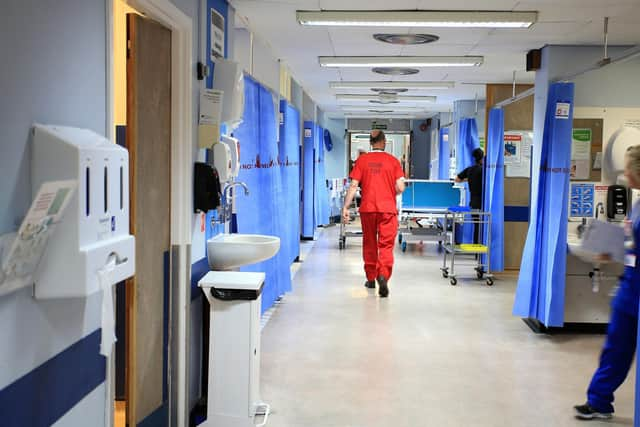Scotland's NHS under attack: Could body-worn cameras help protect healthcare staff from assault? – Martyn McLaughlin
Such a ritual was sentimental, and its harshest detractors rightly argued that it was a poor substitute for better pay. Yet it helped focus attention on those who, to this day, stand tirelessly at the frontline of the pandemic.
Fast forward two years, and what has become of that saucepan-clanging outpouring of gratitude? A clue may be found at today’s meeting of Holyrood’s Citizen Participation and Public Petitions Committee.
Advertisement
Hide AdAdvertisement
Hide AdThis morning, its MSPs will be asked to back a proposal to roll out body-worn cameras for all frontline NHS staff and paramedics in Scotland in an attempt to curb the attacks and abuse they routinely endure.


It may seem unbearably grim to even consider the need for such a step, but the evidence is clear that NHS staff remain particularly vulnerable to attacks.
Statistics obtained at the turn of the year by The Scotsman’s health correspondent, Elsa Maishman, showed that in the 12 months to November 2021, there were a staggering 7,271 incidents of physical assault reported across Scotland’s mainland health boards, along with 5,496 reports of verbal abuse or threats.
While a sizable number of those incidents arise from patients with complex conditions and challenging behaviour, a great many others are borne from Scotland’s troubled relationship with drink, drugs, and violence.
The extraordinary challenges posed by the pandemic have also intensified the problem. The fact that so many Scots are on lengthy waiting lists for routine care such as knee and hip surgery has fuelled frustration and stoked tempers, leading to more abuse.
As a consequence, some health boards have rolled out advanced aggression training for workers at a time when they are needed at the frontline more than ever. It is a vicious circle, and unless it is broken, staff morale will continue to plummet.
Would body-worn cameras eradicate the threat altogether? Of course not. But it would seem rash to rule out the possibility that it might at least reduce it.
The use of such technology in the NHS is new, but there is a small yet growing body of evidence to suggest that it has a positive effect. Following a trial of body-worn cameras at ambulance services in London and the north east of England last February, thousands of the devices were issued to crews across England last summer.
Advertisement
Hide AdAdvertisement
Hide AdThe cameras, which are roughly the same size as a smartphone, are even being used by some designated clinical staff in A&E departments in an attempt to create a safer environment.
In Scotland, authorities are more cautious about using the body-worn video tech. The proposal was first floated three years ago, but the Scottish Government argued the the costs involved – around £7,600 for each camera and its various accessories – did not represent value for money.
Yet that could be about to change, regardless of the Holyrood committee’s deliberations. Since last year, the Scottish Ambulance Service (SAS) has been conducting a limited trial of the technology. The evaluation of the project has been hampered by the extreme pressures brought about by Covid-19 and staff absences, but the first results are expected towards the end of the year.
As things stand, all frontline ambulances in Scotland are fitted with CCTV which records traffic around the vehicle. There is also the option for crew members to switch on a recording device which captures footage from inside the ambulance itself, with staff also able to activate an ambient listening function on Airwave radios.
Some in the SAS feel that this status quo is sufficient and proportionate, but there are others who believe that more visible deterrents are required in order to prevent attacks on staff – if a would-be aggressor can see that a camera is recording footage which may be used in a later prosecution, the argument goes, they are more likely to stand down.
Indeed, in its submissions to the committee, the SAS states that evidence from across the UK suggests that violence against ambulance workers is an increasing trend. The attacks, it said, are many and varied, with the use of weapons, such as knives or guns, becoming more prevalent.
In this context, it seems prudent to keep an open mind when it comes to bodycams. Naturally, the use of technology that is already widely deployed in policing is contentious when it comes to the NHS, and it raises searching questions about patient confidentiality and the use of data – there is understandable reluctance on the part of those professionals who believe openness and trust are essential tools in their day-to-day work.
At the same time, however, the likes of the SAS points out the technology could have untapped potential. One example is the opportunity to livestream patient information from inside ambulances to other clinicians.
Advertisement
Hide AdAdvertisement
Hide AdIt is a sad reflection on our society that we need to balance such concerns at all, yet here we are. We must listen to those clinical and administrative workers in the health service who harbour genuine concerns for their safety.
So too, we must ask questions of the government. Whatever the future holds for this technology, it cannot become a sticking plaster for inadequate staffing levels, or a substitute for robust training and other safeguards designed to protect NHS staff from harm.
